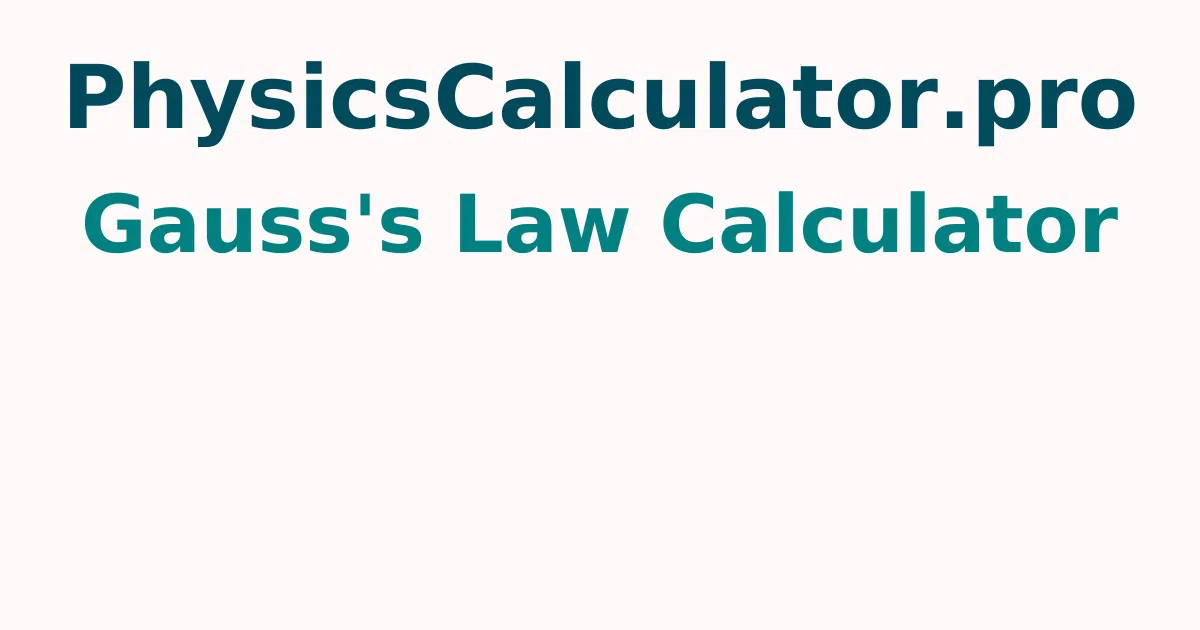Gauss's Law Calculator
You can use our Gauss law calculator to calculate the size of the electric flux generated by an electric charge's electric field. We will begin by exploring what electric flux is, followed by Gauss's law, as well as the magnitude of the electric charge in relation to the whole electric flux.
What is Gauss's Law?
A square surface surrounding an electric charge of a given strength has a total electric flux that is solely dependent on the strength of the electric charge; it cannot be influenced by the shape or size of the surface, nor by the exact position and distribution of the electric charge within that surface.
Gauss's Law Equation
The Gauss' law equation states that: ╧ò = Q/εΓéÇ
- Where Φ = electric flux through the closed surface
- Q = total electric charge inside the surface
- ε0 = electric constant and also called vacuum permittivity or permittivity of free space. ε0 = 8.854·10-12 F/m.
How do you use Gauss Law to Calculate the Electric Field?
Normally, the Gauss law is used to calculate the electric field of symmetric charge distributions. When using this law to solve the problem of the electric field, there are multiple processes involved.
- In the first instance, we must determine how the charge distribution is spatially symmetric.
- After choosing a Gaussian surface that has the same symmetry as the charge distribution, the next step is to determine its kinematics. Its consequences must also be determined.
- Calculate the flux across the surface by evaluating the integral ΦsE over the Gaussian surface.
- Charge the Gaussian surface by calculating its charge.
- Calculate the charge distribution's electric field.
In order to determine the electric field, students must remember the three types of symmetry. The following are some symmetry
- Spherical symmetry
- Cylindrical symmetry
- Planar symmetry
Incorrect coordinate systems must be calculated with the correct Gaussian surface for symmetry.
How to Use Gauss's Law Calculator?
To calculate the Electric potential follow the below steps manually when there is no calculator.
- You can use Gauss's law calculator to get the electric flux by entering the value of the electric charge Q, or you can provide the electric flux and the calculator will give you the appropriate electric charge Q.
- You can also view the exact value of the vacuum permittivity 0 in Advanced mode. Remember that it is constant and should only be modified in exceptional circumstances.
- To obtain flux and charge quantities of similar orders of magnitude, the unit of electric charge is set by default to nC (nanocoulomb). The electric charge can be expressed in a different unit.
For more concepts check out Physicscalculatorpro.Com to get quick answers by using the free tools available.
FAQs on Gauss Law Electric Field Calculator
1). What is the purpose of Gauss law?
Gauss's Law applies to any closed surface. It's a useful tool since it allows you to calculate the amount of confined charge by mapping the field on a surface outside of the charge distribution. It makes calculating the electric field easier for geometries with enough symmetry.
2). Is the Weber electric flux SI unit?
In the International System of Units (SI), a weber is defined as the quantity of magnetic flux that creates an electromotive force of one volt in an electrical circuit of one turn (one loop of wire) as the flux is reduced to zero at a uniform rate in one second.
3). Mention where Gauss law cannot be applied?
In another universe, where a point charge's field decreases by 1/r^4, Gauss's law isn't going to work. The field will deteriorate considerably more quickly than the surface. In another universe, where the field of a point charge decreases by 1/r^4, nasu said: The law of Gauss will not function.
